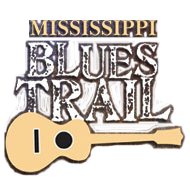Staple Singers
Staple Singers - Drew
Roebuck “Pops” Staples, who lived on the Dockery plantation near Drew in the 1920s and ’30s, was the founder of the Staple Singers, one of America’s foremost singing groups. The group included his children Cleotha and Pervis Staples, who were born at Dockery, and Mavis and Yvonne, who were born after the family moved to Chicago in 1936. Among the Staple Singers’ gospel, rhythm & blues, and pop hits were the No. 1 pop records “I’ll Take You There” and “Let’s Do It Again.”
The Staple Singers, who brought messages of love, hope, and peace to audiences for half a century, built their distinctive sound on gospel and blues traditions from the Drew area. Family patriarch Roebuck “Pops” Staples (1914-2000) was born near Winona and around 1923 moved with his parents and siblings to Will Dockery’s plantation near Drew, an important breeding ground for Delta blues. Staples was inspired to take up guitar by local blues artists Charley Patton, Howlin’ Wolf, Dick Bankston, and Jim Holloway, and was soon performing at local juke joints. By fifteen he was singing with gospel groups, and continued to do so after moving to Chicago, where he formed the Staple Singers in 1948. The group initially featured his children Cleotha (b. 1934), Pervis (b. 1935), and Mavis (b. 1939) and first recorded for Pops’ own Royal label in 1953.
The group gained national attention with the 1956 hit “Uncloudy Day” on the Vee-Jay label, and in the early ‘60s were refashioned as a “folk gospel” group. They became active participants in the civil rights movement, recording anthems including “Freedom Highway” and “Why (Am I Treated So Bad),” a favorite of their close friend Dr. Martin Luther King, Jr. In 1968 the Staples signed with Stax Records, where they had numerous hits with positive message songs including “I’ll Take You There” and “Respect Yourself.” Pervis left the group to pursue artist management and song publishing and was replaced by sister Yvonne (b. 1937). The group’s last major hit was the Curtis Mayfield-penned “Let’s Do It Again” (1975). Both Mavis and Pops later had successful solo careers.
Artists who lived in the Drew area in the post-World War II era include guitarist Boyd Gilmore (c. 1910-1976), whose early ‘50s recordings for Modern featured Ike Turner on piano and included covers of Robert Johnson songs. Gilmore also recorded for Sun and later moved to California. Drummer Kansas City Red (Arthur Lee Stevenson, 1926-1991) played with Robert Nighthawk before moving to Chicago, where he led bands and ran nightclubs. Singer James Kinds, born near Drew in 1943, began singing blues at one of Red’s clubs and later recorded several albums in Dubuque, Iowa, and Chicago. Local fiddler Sylvester Davis founded the Lard Can Band, which included his children James (“Boo Boo”) on drums, John on guitar, Sylvester, Jr. on bass, and Clara on vocals. The siblings also played with local bluesman “T-Bone Walker” Joe Louis in the ’50s and later performed together in East St. Louis as the Davis Brothers Blues Band. Vocalist-pianist Homer Harris (1916-2000) is best known because Muddy Waters appeared on his lone 1946 session for Columbia in Chicago, while Charles “Guitar” Friday (1934-2003), a veteran of the Memphis blues scene, recorded a 1966 single for Excello, and schoolteacher-keyboardist Jesse Gresham (b. 1947) recorded for the Jewel label in 1971 before becoming a pastor in Drew.
content © Mississippi Blues Commission
[ BACK TO TOP ]

